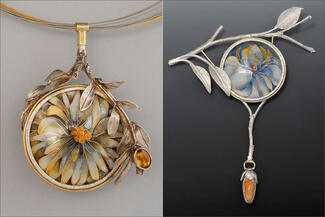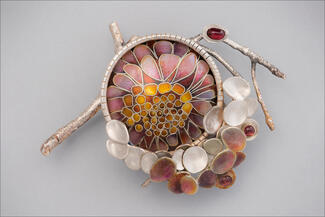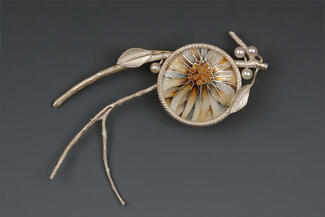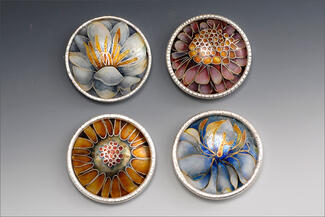Enameling: Cloisonné
Learn the ancient art of enameling with transparent colors from master enamelist, Linda Darty. Discover ways to use transparent colors to create depth and luminosity on copper, fine silver, or silver metal clay surfaces. We will focus on blending colors to achieve value gradations, creating matte or gloss finishes for optimum clarity of colors. Topics covered will also include use of cloisonné wire, foils, sifting, washing and storing enamel, making settings, and soldering and metal fabrication as it relates to enameling. During the course students can create small jewelry pieces or samples, investigating wet inlay techniques that interest them most. This class will allow both beginners and those with experience to work at their own level.
Meet the instructor

Linda is a jewelry and enameling professor at East Carolina University and founder/ director of their ECU Tuscany study abroad program, where she currently lives and teaches. She has an extensive international exhibition record, is the author of The Art of Enameling, and frequently teaches workshops on enameling in this country and abroad. Linda is the recipient of the Lifetime Achievement Award for research from East Carolina University, the Board of Governors Award for teaching excellence and the Life -Time Achievement Award from The Enamelist Society. Her work is in public and private collections including the Victoria and Albert Museum in London, the Museum of Art and Design in NYC, Yale University Art Gallery, Philadelphia Museum of Art, Arkansas Museum of Fine Arts and the Crocker Art Museum.
Materials & Tools
For those who would like to purchase a sample kit of lead bearing enamels and a paintbrush, the cost will be $60, which is payable directly to the instructor on the first day of class. The kit will include about 24 different Ninomya and old Thompson leaded transparent enamel samples. Students are certainly welcome to bring their own enamels and enameling supplies or use the supplies at Metalwerx. Linda will additionally have some quantities of other consumable materials available for sale a-la-cart in limited quantities.
-
Students are asked to supply their own metal and can work on either copper or fine silver (or both). Linda recommends 20–22 gauge metal. 22 gauge is good for small formed pieces and will result in a piece that is lighter weight. For larger pieces or pieces that will not be dapped or formed at all, 18 or 20 gauge is less likely to warp.
-
Linda will also have cloisonné wire, small paintbrushes, and silver foil for those who need to purchase them, but it is suggested students bring their own.
-
Pencils (you might like to also have colored pencils for designing)
-
Basic consumables such as sawblades
-
Sharpie fine tip marker
-
Small, sharp embroidery type scissors
-
Tracing paper and sketchbook
-
At least 12 small containers for washing enamels (spice, small condiment cups, etc)
-
Water color tray or a dozen plastic spoons - that can be covered (with lid or tin foil)
-
Sharp, pointed, clean tweezers for handling cloisonne wire
-
Eyedropper- cheap one from the drug store or amazon
-
Safety dust mask (good one…I like a 3M-#8233 -available from Allcraft) and plastic bag to store it
-
Silver or Gold foil if you want to use that (I will have some silver foil for sale)
-
Your own favorite tools
-
000 paintbrush for inlaying enamel (I will have some for sale)
-
A very small plastic spoon or tiny scooping tool for transferring enamel from jars
-
320, 400 and 600 grit wet/dry sanding paper for finishing cloisonné surfaces
-
Metalwerx has the following, but you can bring your own:
-
Small hand towel
-
Green scotchbrite pad for cleaning metal
-
6” flat hand file, any cut (simply for filing edges of metal sheet)
-




